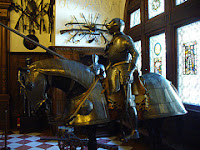Located on Peles brook valley, on the spot named Pietrele Arse (The Burnt Stones) The Peles Castle , is the most famous royal residence in Romania, built between 1875 and 1883. It is said that sometime in august 1866 King Carol I arrived in the neighborhood and spent the night at the monastery of Podul Neagului ( as Sinaia was known at that time). He liked so much the wild and picturesque landscapes that he decided to built here a castle. So he bought the land in 1872 and then hired the German architect Wilhelm Doderer to make the plans for the construction. That is why, in what concerns the exterior architecture, the main elements are specific to the German neo-renaissance style.
The Peles Castle was and is considered to be one of the most beautiful castles in Europe, and the first to be entirely electrified on the continent. Having its own power station, at that time the building had an interior elevator, vacuum cleaner and central- heating system. The castle has 170 rooms, out of which only 10 can be visited by tourists and shelters various valuable collections of paintings, sculptures, armors, carpets, furniture, tapestries, statues, potteries, gold, silver and china dishes, stained-glasses.
The Entrance Hall is magnificent, with walnut tree carvings, covered with bas-reliefs and statuettes. The movable glass ceiling, activated by an electric engine or by a manual system, was a surprise element for the king’s visitors, who could admire the sky on cloudless summer nights.
The Royal Library attracts especially those who are keen on rare books, with leather covers engraved with golden letters. There is an attraction point even for those who are not familiar with the universe of books, namely the secret door, a way of access behind a book shelf through which the king could becalm in various rooms of the Castle.
The armories, arranger between 1903 and 1906, shelter more than 4000 European and Eastern prices from the 14th and 17 centuries. The most valuable are considered to be the German armors from the 16th and 17th centuries and a complete amour for horse and knight, unique in Romania.

The Music Room became a musical soiree salon at Queen Elisabeth’s wish. The furniture from this room was a gift from the Maharajah of Kapurthala. The Florentine Room, also called the Great Salon, impresses with its ceiling sculptured out of linden trees, gilded, with two great chandeliers, and its ornaments in the Italian neo-renaissance style. Maura Salon is the work of architect Charles Lecompte de Nouy, having Spanish –Moorish elements and an indoor Carrara marble fountain, replica of a similar piece in Cairo. The Playhouse has 60 seats and a royal box, being decorated in Louis XIV style. At first floor there is the Concert Room, arranged in 1906, where one can find a harpsichord made in 1621 at Antwerp, a Bluthner piano with vertical tail and Rieger organ with two keyboards. The Imperial Suite was also arranged in 1906, for the Austro-Hungarian emperor Franz Josef, invited at King’s Carol I celebration of 40 years of reign. Other rooms that offer the tourist various surprises are: The Council Room, which resembles one of the rooms of the mayoralty in Lucerne – Switzerland; The Work Cabinet where there is an imposing writing table and also an audience desk; The Dinning Room, where there are exhibited some very valuable silver pieces, is at the first floor and has a rustic, Briton furniture from the 18th century; The Turkish Parlor which shelters a collection of Turkish and Persians brass pots. Peles Castle is considered one of the most visited museum in Romania. Only in 2006 there were over 250.000 visitors from Romania and also from USA, Australia, Japan and New Zeeland.
So if you want to be impressed by the beauty of the architecture and the valuable collections of Peles Castle, just book your vacation in Romania, through www.medestino.com.




















